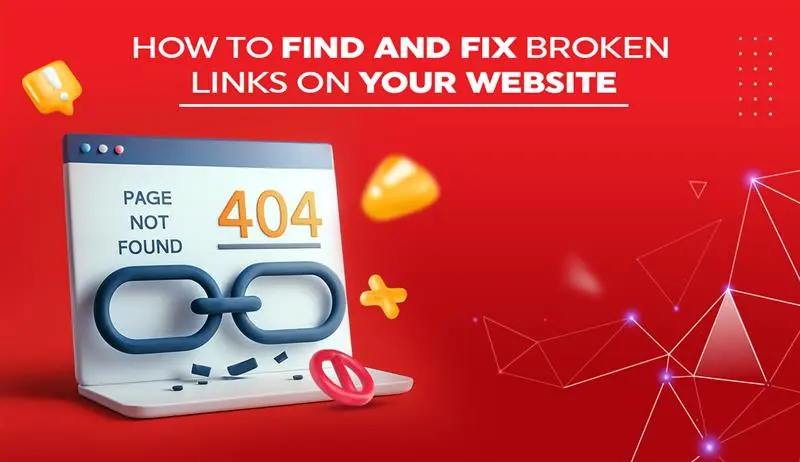A single broken link can harm user experience and hurt your search rankings. Visitors expect smooth navigation and relevant information when browsing your website. When they click a link that leads nowhere, trust in your brand drops instantly. Search engines also treat broken links as a sign of poor website maintenance, which can lower your site’s visibility. Regularly checking and fixing these links keeps your site professional, reliable, and competitive in the online space.
What is a Broken Link?
A broken link, also called a dead link, is a hyperlink that no longer works. Instead of leading to the intended page, it often displays a 404 error or a “page not found” message. This can happen when a linked page is deleted, moved without a redirect, or the URL is entered incorrectly.
Broken links can occur on any website, regardless of size. Large e-commerce stores, small business sites, and blogs are all equally vulnerable. Sometimes, they are caused by small changes like file renaming or accidental URL edits. Even if the error is minor, the impact can be significant if left unresolved.
How Broken Links Affect A Website?
Hurts Search Rankings
Search engines use website quality as a ranking factor. A site filled with broken links signals poor upkeep. Over time, this can lower rankings, reduce impressions, and push competitors ahead in search results. Since rankings are linked to visibility and traffic, the effect can be costly for a business.
Damages User Trust
Visitors rely on working links to navigate your site. If they repeatedly land on error pages, they may question your brand’s reliability. High bounce rates and reduced return visits are common signs of damaged trust. First-time visitors may not come back if their experience is frustrating.
Reduces Conversion Opportunities
Links often guide users to important actions, like product purchases or service inquiries. When these paths break, you lose valuable leads and sales. Even one broken link in a sales funnel can disrupt the buying process. For websites with paid ads or campaigns, this can waste marketing budgets.
How To Find Broken Links?
Use Online Tools
Manual checking is time-consuming and prone to errors. Tools like Online Broken Link Checker scan your entire site and flag every broken link, including hidden ones in menus, footers, or blog archives. They provide detailed reports with URLs, anchor text, and the source page, allowing for faster fixes.
Check Google Search Console
Google Search Console offers a free way to monitor crawl errors, including broken links. It not only highlights problematic URLs but also shows how search engines view your site. Regularly checking these reports ensures that issues are fixed before they affect rankings.
Review Internal and External Links Separately
Internal links connect pages within your site, like a blog post linking to a product page. External links point to other websites or resources. Internal link errors are within your control, while external link errors may require finding replacement sources. Treating them separately ensures a focused approach.
Work With Experts
A digital marketing agency in Orlando, such as Markethix, can integrate broken link checks into your regular SEO maintenance. With advanced tools, industry experience, and automation, they can detect and fix issues quickly. Professional support ensures your site remains healthy without taking up your internal resources.
How To Fix Broken Links?
Update The URL
If the linked page still exists but the address has changed, simply update the URL. This quick fix is common for pages that were moved during redesigns or structure changes. Always test the link after updating to ensure it works correctly.
Redirect The Page
A 301 redirect is a permanent way to send visitors from a deleted or moved page to a new one. This prevents users from seeing error messages and helps preserve SEO value. Redirects should point to the most relevant page, not just the homepage, for a better user experience.
Remove The Link
When a page is permanently gone with no alternative, removing the link is the cleanest option. Leaving a dead link in place only confuses visitors and lowers trust. Clean, functional pages send a stronger quality signal to search engines.
Replace With New Resources
If an external source is no longer available, find a suitable replacement. Ensure the new link is from a trustworthy site with accurate information. This not only fixes the broken link but can also improve content value for your audience.
Use Regular Maintenance Schedules
Websites grow and change over time, making regular link checks essential. A quarterly or monthly audit can catch issues early. Partnering with an SEO company in Orlando ensures broken links are found and fixed before they impact performance.
How to Avoid Broken Links?
Use Descriptive Link Text
Link text should clearly describe where the link leads. Avoid vague phrases like “click here” that make tracking harder. Descriptive text also improves accessibility for screen readers.
Avoid Linking To Temporary Content
Links to seasonal promotions or short-term campaigns can break once the content is removed. Only link to permanent pages unless you have a plan to update them regularly.
Monitor Third-Party Links
External websites can change, restructure, or remove content without warning. Regular monitoring ensures these changes do not leave your site with outdated references. Partnering with the best SEO company in Florida can provide continuous oversight.
Keep A Link Audit Log
Maintain a record of important links in a spreadsheet or tracking tool. During audits, this helps ensure no key links are missed. It also simplifies updates when site changes occur.
The Bottom Line
Broken links affect both experience and search rankings. They can cause lost traffic, lower conversions, and damage your brand’s credibility. Using tools like Online Broken Link Checker, updating URLs, setting redirects, and replacing outdated resources are effective solutions. Regular link maintenance ensures your website remains functional, professional, and valuable to both users and search engines. A healthy site keeps visitors engaged and encourages them to return, building long-term trust and growth.






0 Comments